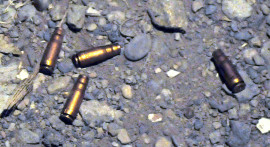1602907630-0/tomb-of-Khan-e-Jahan-Zafar-Jang-Kokaltash-(6)1602907630-0.jpeg)
Situated in the heart of Lahore’s Larechs Colony, is the ancient tomb of Khan-e-Jahan Zafar Jang Kokaltash, a nobility from the court of Mughal Emperor Aurangzeb Alamgir. Built in 1697, the tomb once spoke of Kokaltash’s prominence in the royal court.
Believed to be the reigning Maharaja’s foster brother, he was appointed as a governor and admired for his advocacy and administration. However, the centuries-old monument, which can be seen at a distance while crossing the city’s Canal Road, stands today only but a dilapidating remnant of its former glory—ebbing away in neglect at the unforgiving hands of time.
In 2018, The Punjab Archaeological Department had started some restoration work at the historic site but citing non-availability of funds, the efforts eventually came to a halt. Archeologists working on the site believe that most structural damage to Kokaltash’s tomb came from earthquakes at various periods during the Indo-Pak war.
According to Punjab Archaeology Department Conservation Foreman Abdul Waheed Farooqui, Kokaltash was the administrator of Lahore during rule of Mughal Emperor Aurangzeb Alamgir. He was appointed as the Subedar of Lahore in April 1691, but was eventually disposed in June 1693, following which he passed away in Kolahor on November 23, 1697.
“The tomb was built shortly after Kokaltash’s death but suffered great damage during the period of IndoPak war. A railway colony has since been built around the site.
The tomb’s decorative marble-work was nicked during the reign of Maharaja Rangit Singh, while it was also converted into a dance hall during the British times,” shared Farooqui. As per the conservation foreman, the tomb’s restoration was first estimated to come around at the cost of Rs27 million in 2018, but the budget is now in the process of being reviewed and re-estimated.
“Two of the eight-sided mausoleum’s pillars were damaged in the 1970s, but we were able to restore them back in place. So far, almost 75 per cent of the site’s restoration work stands complete, but the unavailability of funds has really stalled the process,” he informed. Khan-e-Jahan Zafar Jang Kokaltash’s mausoleum is mounted on a high platform.
Right in the centre of the mausoleum is the tomb, which had to be rebuilt. “There are several such historic sites in the city, including the tombs of Ali Mardan and Nusrat Jahan, which have fallen prey to encroachers and land-grabbers over the years. We had to fence Kokaltash’s tomb with iron bars to prevent it from suffering a similar fate, while trees and shrubs will be planted on the mausoleum’s unoccupied land to beautify the area,” Farooqui told The Express Tribune.

1602907664-3/tomb-of-Khan-e-Jahan-Zafar-Jang-Kokaltash-(14)1602907664-3.jpeg)
1602907663-1/tomb-of-Khan-e-Jahan-Zafar-Jang-Kokaltash-(12)1602907663-1.jpeg)
1602907664-2/tomb-of-Khan-e-Jahan-Zafar-Jang-Kokaltash-(13)1602907664-2.jpeg)
1602907662-0/tomb-of-Khan-e-Jahan-Zafar-Jang-Kokaltash-(11)1602907662-0.jpeg)
1602907631-2/tomb-of-Khan-e-Jahan-Zafar-Jang-Kokaltash-(8)1602907631-2.jpeg)
1602907631-1/tomb-of-Khan-e-Jahan-Zafar-Jang-Kokaltash-(7)1602907631-1.jpeg)
1602907630-4/tomb-of-Khan-e-Jahan-Zafar-Jang-Kokaltash-(10)1602907630-4.jpeg)
1602907629-3/tomb-of-Khan-e-Jahan-Zafar-Jang-Kokaltash-(9)1602907629-3.jpeg)
1602907575-3/tomb-of-Khan-e-Jahan-Zafar-Jang-Kokaltash-(4)1602907575-3.jpeg)
1602907574-4/tomb-of-Khan-e-Jahan-Zafar-Jang-Kokaltash-(5)1602907574-4.jpeg)
1602907573-2/tomb-of-Khan-e-Jahan-Zafar-Jang-Kokaltash-(3)1602907573-2.jpeg)
1602907573-1/tomb-of-Khan-e-Jahan-Zafar-Jang-Kokaltash-(2)1602907573-1.jpeg)
1602907568-0/tomb-of-Khan-e-Jahan-Zafar-Jang-Kokaltash-(1)1602907568-0.jpeg)
1725523665-0/Minecraft-Movie-(1)1725523665-0-405x300.webp)



1732086766-0/BeFunky-collage-(74)1732086766-0-165x106.webp)

1732011525-0/Express-Tribune-(8)1732011525-0-270x192.webp)










COMMENTS
Comments are moderated and generally will be posted if they are on-topic and not abusive.
For more information, please see our Comments FAQ